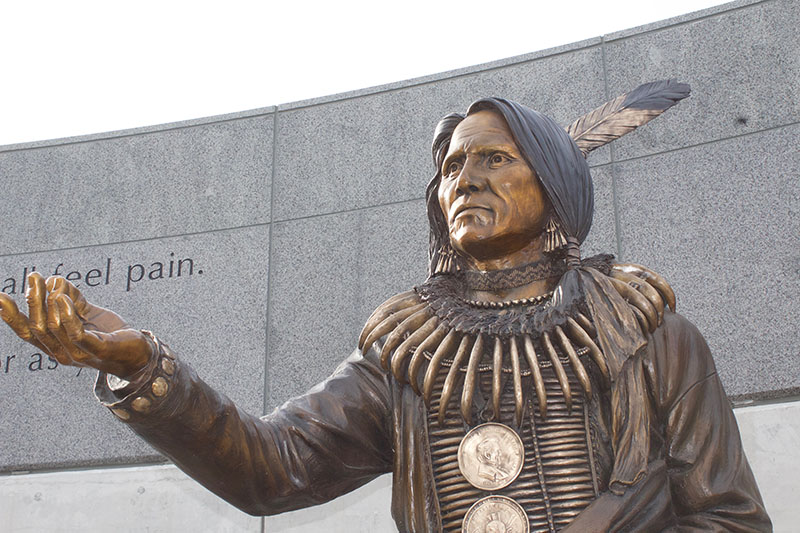By: Cheney Hurley –
The Lincoln community is finally trying to give Chief Standing Bear of the Ponca Tribe some of the respect he deserves with the unveiling of a bronze statue, in his honor, that was placed in front of the College of Journalism and Mass Communications at the University of Nebraska-Lincoln on Centennial Mall on Oct. 15. The 11 foot statue was created by sculptor Ben Victor and encompasses very detailed work from the distinct features on Standing Bear’s face to the beads on his moccasins.
Chief Standing Bear has long been a martyr to the cause of Native American rights and continues to make a difference even after his death. Chief Standing Bear was born in Nebraska, somewhere along the Niobrara River, and from that day to his death in 1908, he fought for equality and equal representation for his people.
In 1877, the Ponca Tribe was forced, by federal treaty, to migrate to land in current day Oklahoma, known as Indian Territory. The travel to Indian Territory was hard for the Ponca tribe and many died, including Chief Standing Bear’s 16-year-old son.
Before he died, he told his father his last wish was to be buried on the land he was born, in Nebraska, so his soul would not wander forever in an unknown land. Chief Standing Bear was determined to make his son’s final wish come true so he led 30 members of his tribe back to Nebraska, but they were stopped by law enforcement and arrested for leaving the reservation.
A journalist from the Omaha Daily Herald happened to hear and write about their story and then proceeded to find a couple of lawyers to help Chief Standing Bear and the group. In 1879, a federal court decision was made that said that Native Americans are people and Chief Standing Bear was the first Native American to be recognized as a person. This court decision established that Native Americans are entitled to the rights that every other American citizen possesses and are protected by the 14th amendment.
Although Native Americans were finally considered people legally, this does not mean they were actually treated as people. People had belittled and disregarded Native Americans years prior to Chief Standing Bear and, unfortunately, many continued to after the court decision, but many things have changed since then with people giving Native Americans more respect, even with racism being a prominent issue in today’s society.
Native Americans are a very underrepresented population in Nebraska and in Lincoln Southeast High School. According to the U.S. Census, there were 18,427 American Indians in Nebraska in 2010, or about one percent of Nebraska’s population. The American Indian and Alaskan Native population of Southeast had an even lower percentage of people represented with 0.62 percent, or 13 people.
Junior Mimi Robles is one of the few Native Americans at Southeast. While she is not fully Native American (half Mexican, half Native American), she still embraces her Native culture. It is much more than this, however. Robles has to overcome a lot of adversity simply because she is Native American, but also being Mexican gives her even more of a challenge. She has learned how to put herself in other people’s shoes so she can help them understand that she is both Mexican and Native American.
“On the res, it’s really hard because they’re fully Native and they look at you as a half breed and they don’t think you are [Native American]. [My sister and I] always get counted as Mexican and people try to speak to us in Spanish, which we don’t understand,” said Robles. “I correct them. You have to sit there and acknowledge they probably don’t know your background and you correct them and [say], ‘No, I’m Native, too.’”
Robles thinks that putting up a statue of a Native American is a step in the right direction towards true equality and respect for Native Americans. However; she also knows that one statue will not solve the hundreds of years of disparagement and systematic oppression of Native Americans and their culture.
“I feel like Native Americans have gone through a lot of things and a lot of tragedy. I feel like them having a statue of someone that isn’t here anymore, but representing them, is a good idea to have for their culture,” said Robles.
A vital question that has been asked or should be asked is: Was this statue put up as a sign of respect toward the Native American population or was it made just to appease them? Robles answers this tough question that has no right answer by pointing out that the statue brings many positive things that seemed to outweigh the negative.
“[The statue] is probably there to make [Native Americans] happy, but it’s going to lead into people giving Native Americans respect and acknowledging them; I think it’s respecting the natives. [However], there could [always] be more statues of different warriors and other stuff going on with the Native American community.”
Angel Geller of the Omaha tribe, a sister tribe of the Ponca, was very satisfied with the unveiling of the statue, saying in an interview with the Lincoln Journal Star, “Nebraska had really poor relationships with the indigenous community for almost as long as Nebraska’s been a state. To have a presence on the walkway up to the Capitol is very beautiful.”
The Chief Standing Bear sculpture is a great step in the right direction for the Native American community and it will help bring awareness towards their greatly underrepresented culture.


